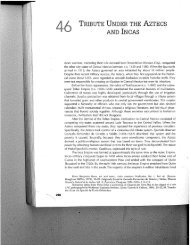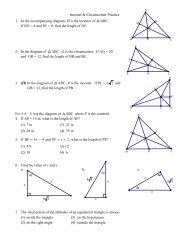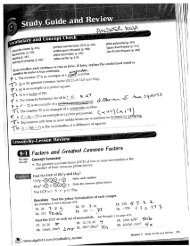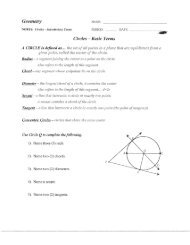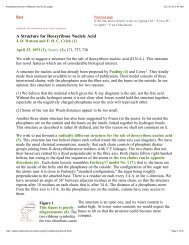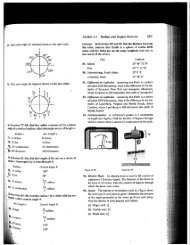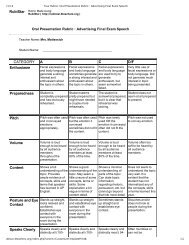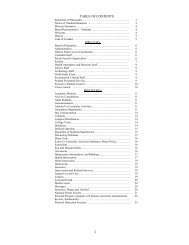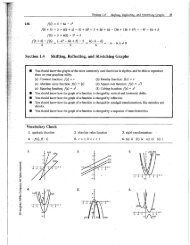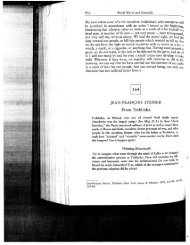The Byzantine Empire - Pascack Valley Regional School District
The Byzantine Empire - Pascack Valley Regional School District
The Byzantine Empire - Pascack Valley Regional School District
You also want an ePaper? Increase the reach of your titles
YUMPU automatically turns print PDFs into web optimized ePapers that Google loves.
204<br />
Tatars)<br />
1453 Ottoman<br />
Turks capture<br />
Constantinople;<br />
end of <strong>Byzantine</strong><br />
Emoire<br />
1480 Expulsion of<br />
Tatars from Russia<br />
not Previo~Sl<br />
Just as<br />
in arts p 3~<br />
: <strong>Byzantine</strong>s - be g an{3<br />
Balkans and<br />
Belarus as<br />
betweei<br />
Europe.<br />
partly<br />
CHAPTER 9 ¯ Civilization<br />
duced different versions of Christianity that were cup<br />
turally as well as organizationally separate, even hostile.<br />
<strong>The</strong> civilizations had little mutual contact. Until late in<br />
this period, commercial patterns in both cases ran<br />
south to north rather than east to west. During most of<br />
the postclassical rnillennium, major portions of eastern<br />
Europe were significantly more advanced than western<br />
Europe !n politica! sophistication, cultural range, and<br />
economm vitality. When the two civilizations did meet,<br />
in this period and later, they met as distant cousins,<br />
related but not close, kin.<br />
<strong>The</strong> <strong>Byzantine</strong> <strong>Empire</strong><br />
<strong>The</strong> <strong>Byzantine</strong> <strong>Empire</strong> was shaped by the<br />
decline of the Roman <strong>Empire</strong> and the rise of<br />
the Arabs. <strong>The</strong> empire weathered many<br />
attacks and flourished for several centuries.<br />
senses began in the 4th<br />
c.E., when the Romans set up their eastern<br />
ple. This city quickly became the<br />
center of the otherwise fading imperial<br />
Emperor Constantine constructed a host of<br />
ags, including Christian churches, in his<br />
city, which was built on the foundations ofa previmodest<br />
town called Byzantium. Soon, separate<br />
the new metropolis, even<br />
the western portion of the empire fell to the<br />
<strong>The</strong>y warded off invading Huns<br />
&ile enjoying a solid tax base in<br />
~he eastern Mediterranean.<br />
was responsible fbr the Balkan peninnorthern<br />
Middle East, the Mediterranean<br />
h AtHca. Although for several centuries<br />
the court language of the eastern empire,<br />
the common tongue, and after E~nperorJusthe<br />
6th century, it became the official ian-<br />
Indeed, in the eyes of the easterners,<br />
inferior, barbaric means of commu-<br />
Knowledge of Greek enabled the scholars of<br />
:reely in the ancient Athenand<br />
literary classics and in the HeP<br />
~ and scientific treatises.<br />
from the high levels of<br />
in the eastern Mediterranean.<br />
into administration and trade as<br />
Syrians, long excluded ti’om<br />
inistrati0n, moved to Constantinople and<br />
bureaucracy of the <strong>Byzantine</strong><br />
empire faced many foreign enemies,<br />
in Eastern Europe: Byzantium and Orthodox Europe 197<br />
although the pressure was less severe than that provided<br />
by the Germanic tribes in the West. It responded by<br />
yecruiting armies in the Middle East it,sel*; not by relying<br />
on barbarian troops. Complex administration<br />
around a remote emperor, who was surrounded by<br />
elaborate ceremonies, increasingly defined the<br />
empire’s political style.<br />
<strong>The</strong> early history of the <strong>Byzantine</strong> <strong>Empire</strong> was rnarked<br />
by a recurrent threat of invasion. Eastern empm’ors,<br />
relying on their local military base plus able<br />
generalship by upper-class Greeks, beat off<br />
attacks by the Sassanian <strong>Empire</strong> in Persia and<br />
by Germanic invaders. <strong>The</strong>n, in 533 c.~;., with<br />
the empire’s borders reasonably secure, a Emperor<br />
new emperm; Justinian, tried to reconquer<br />
Just[Nan<br />
western territory in a Iast futile effort to restore an<br />
empire like that of Rome. He was sombre; autocratic,<br />
and prone to grandiose ideas. A contemporary historian<br />
named Procopius described him as "at once villainous<br />
and arnenable; as people say colloquially, a<br />
moron. He was never truthful with anyone but always<br />
gu leful in what he said and did, yet easily hoodwinked<br />
by any who wanted to deceive him." <strong>The</strong> emperor was<br />
also heavily influenced by his wi~ <strong>The</strong>odora, a courtesan<br />
connected with Constantinople’s horse-racing<br />
world, who was eager ~br power. <strong>The</strong>odora stifferied<br />
J stm~an s resolve in response to popular um’est and<br />
pushed the plans for expansion.<br />
Justinian’s positive conuibutions to tbe <strong>Byzantine</strong><br />
<strong>Empire</strong> lay in rebuilding Constantinople, ravaged by earlier<br />
riots against high taxes, and systematizing the<br />
Roman legal code. Extending later Roman architecture,<br />
with its addition of domes to earlier classical styles, Justinian’s<br />
builders created many new structures, the most<br />
inspiring of which was the huge new church, the Hagia<br />
Sophia, long one of the wonders of the Christian world.<br />
This was an achievement in engineering as wei! as architecture,<br />
tbr no one had previously been able to build the<br />
sut~ports needed for a dome of its size. Justinian’s codificanon<br />
of’ Roman law reached a goal earlier emperors<br />
!tad sought but not achieved, summing up and reconciling<br />
many prior edicts and decisions. Unified law not only<br />
reduced conthsion but also united and organized the<br />
new empire, paralleling the state’s bureaucracy. Updated<br />
by later emperors, the code ultimately helped spread<br />
Roman legal principles in various parts of Europe.<br />
Justinian’s military exploits had more ambiguous<br />
results. <strong>The</strong> emperor wanted to recapture the old<br />
Roman <strong>Empire</strong> itself. With the aid of a brilliant genm~l,<br />
Bellsarlus, new gains were r~a?te’: in north AlHca and<br />
Italy. Justinian’s forces made their temporary capital,
198<br />
PART I1| ¯ <strong>The</strong> PostclassicN Period, 500-!450: New Faith and New Commerce<br />
Ravenna, a key artistic center, embellished by some ~f<br />
the most beaugfful Christian mosaics known anywhere m<br />
the world (Figure 9.2). But the major Italian holdings<br />
¯ - ble to witbstand Germanic pressure,<br />
were short-hveCt, una<br />
and north African territory was soon besieged as well.<br />
Furthermore, Jusnman westward ambitions had<br />
weakened the empire in its own sphere. Persian forces<br />
attacked in the northern Middle East, while<br />
new Slavic groups, moving into the Balkans,<br />
pressed on another front (Map 9.1).Justinian<br />
finally managed to create a new line of<br />
<strong>The</strong> <strong>Byzantine</strong> defense and even pushed Persian ~{br~es back<br />
<strong>Empire</strong> Under<br />
Justinian<br />
again, but some Middle Eastern terrltory was<br />
lost. Furthermore, n!l these wars, ofi~nsive<br />
and defensive alike, created new tax pressures on the<br />
government and forcedJusdnian to exertions that contributed<br />
to his death in 565 c.I~.<br />
- - *--~.*;~ian’s successors began to con-<br />
Ati~er some setbacKs,3uam*<br />
centrate on defending the eastern empire itself. Persian<br />
successes in the nortbern Middle East were reversed in<br />
the 7th century, and the population was forcibly recon-<br />
¯<br />
verted to Cbristiamty. <strong>The</strong><br />
resultant empire, centered in<br />
the southern Balkans and the western and central portions<br />
of present-day Turkey, was a t~r cry from Rome’s<br />
greatness. However, it was sufficient to amplify a rich<br />
ATLANTIC<br />
MAP 9.1 <strong>The</strong> <strong>Byzantine</strong> <strong>Empire</strong><br />
holdings outside the northeastern MedRerranean within 50 years after his death.<br />
FIGUR~ 9.2 Dazzling mosaics from the early period of the<br />
<strong>Byzantine</strong> <strong>Empire</strong> illustrate some of the highest achievements<br />
of <strong>Byzantine</strong> religious art. This mosaic features a rather militant<br />
Christ the Redeemer¯<br />
Hellenistic culture and blend it more Ihally with Christianity<br />
while advancing Roman achievements in engineering<br />
and military tactics as well as law.<br />
<strong>The</strong> <strong>Byzantine</strong> <strong>Empire</strong> was also strong enough to<br />
withstand ’the great new threat of the 7th century, the
C H A P T E R 9 ¯ Civilization in Eastern Europe: Byzantium and Orthodox Europe 199<br />
of the Arab Muslims, though not without massive<br />
By tile mid-7th centugr; the Arabs had built a<br />
that challenged <strong>Byzantine</strong> naval supremacy in the<br />
Mediterranean while repeatedly attacking<br />
<strong>The</strong>y quickly swallowed tile empire’s<br />
the easteru seaboard of the<br />
~e northern Middle<br />
as well. Arab cultural and commeralso<br />
affected patterns of life in Constanterritory<br />
was cut back to about half<br />
earlier eastern Roman <strong>Empire</strong>.<br />
<strong>Byzantine</strong> <strong>Empire</strong> held out nevertheless. A<br />
r saege of tile capita! in 717-718 c.E. was beaten back,<br />
~ because of a new weapon, a kind of napalm called<br />
fire (a petroleum, quicklime, and sulfur mkxture)<br />
Arab ships. <strong>The</strong> Arab threat was never<br />
entirely. Furthermore, wars with tile Muslims<br />
burdens to the empire, as in~aweakening<br />
the position of small farmgreater<br />
aristocratic estates and new power<br />
population that<br />
during its early cenmries--proz<br />
recruits and pa~ing the bulk of the tmxes-into<br />
greater dependence. Greater emphasis<br />
, and navy.<br />
the greatest Arab onslaughts had been faced,<br />
run by a dizzying series of weak and<br />
[ with seemcontinued¯<br />
Conquest of the<br />
9th century allowed the Muslims<br />
shipping in the Mediterranean for<br />
Slavic kingdoms, especially Bulgaria,<br />
pressed <strong>Byzantine</strong> territory in the Balkans,<br />
times military success and marriage<br />
<strong>Byzantine</strong> control over the feisty Bulwhile<br />
a Bulgarian king in tire<br />
’ took the title of tsar, a Slavic version of the<br />
FIGURE 9.8 A view of the intedor of the Hagia<br />
Sophia--the Church of Holy Wisdom--in what is<br />
today the city of Istanbul, This magnificent<br />
church was built 532-537 c,E, under the reign of<br />
the Emperor Justinian,<br />
word Caesar, steady <strong>Byzantine</strong> pressure<br />
through war eroded the regional kingdom.<br />
In the llth century, the <strong>Byzantine</strong> emperor<br />
Basil II, known as Bulgarohtonos, or slayer of<br />
tile Bulgarians, used the empire’s wealth to bribe many<br />
Bulgarian nobles and generals. He defeated the Bulgarian<br />
army in 1014, blinding as many as 15,000 captive soldiers.<br />
<strong>The</strong> sight of this tragedy brought on tile Bulgarian<br />
king’s death. Bulgaria became part of the empire, its<br />
aristocracy settling in Constantinople and merging with<br />
the leading Greek families.<br />
Briefly, at the end of the 10th century, the <strong>Byzantine</strong><br />
emperor may have been the most power~hl<br />
monarch on earth, with a capital city whose rich buildings<br />
and abundant popular entertainments awed visitors<br />
ti’om western Europe and elsewhere.<br />
<strong>The</strong> <strong>Byzantine</strong> political system had remarkable similarities<br />
to tile earlier patterns in China. <strong>The</strong> emperor was<br />
held to be ordained by God, head of church as well as<br />
state. He appointed church bishops and passed religious<br />
and secular laws. <strong>The</strong> elaborate court rituals symbolized<br />
the ideals of a divinely inspired, all-power~)l<br />
ruler, although they otien immobilized rulers and<br />
inhibited innovative policy.<br />
At key points, women held the imperial throne<br />
while maintaining the ceremonia! power of the office.<br />
<strong>The</strong> experiences of Empress <strong>The</strong>odora (981-1056),<br />
namesake of Justinian’s powerthl wife, illustrate the<br />
complex nature of <strong>Byzantine</strong> politics and the whims of<br />
fate that affected women rulers. Daughter of an<br />
emperor, <strong>The</strong>odora was strong and austere; she<br />
refused to marry the imperial heir; who then wed her<br />
sister Zofi. Zoa was afraid of <strong>The</strong>odora’s influence and<br />
had her confined to a convent. A popular rebellion<br />
against the new emperor installed <strong>The</strong>odora and Zo~<br />
jointly (and one assugm~ ugqasily) as empresses. Later,<br />
<strong>The</strong>odora managed to check unruly nobles and limit
200<br />
New Faith and New Commerce<br />
PART III o <strong>The</strong> Postclassical Period, 500-1450:<br />
bureaucratic corruption, although her severe retaliation<br />
against personal enemies brought criticism.<br />
Supplementing the centralized imperial authority<br />
was one of history most elaborate bureaucracies.<br />
Trained in Greek classics, philosophy, and science in a<br />
secular school system that paralleled ctmrch education<br />
for the priesthood, <strong>Byzantine</strong> bureaucrats could be<br />
recruited fi’om all social classes. As in China, aristocrats<br />
predominated, but talent also counted among this<br />
elite of highly educated scholars. Bureaucrats were specialized<br />
into various offices, and officials close to tire<br />
emperor were mainly eunuchs. Provincial governors<br />
were appointed fi’om the center and were charged<br />
with keeping tabs on military authorities. An elaborate<br />
system of spies helped preserve loyalty while creatmg<br />
intense distrust even among friends. It is small wonder<br />
that the word Byzar~ti’rze came to refer m complex institutional<br />
arrangements. State control of the church and<br />
its appointment of head church oiticials was another<br />
key aspect of the government structure.<br />
Careful military organization arose as well, as Figqare<br />
9.2 suggests. <strong>Byzantine</strong> rulers adapted the later Roman<br />
system by recruiting troops locally and rewarding them<br />
with grants of land in return for their military service.<br />
<strong>The</strong> land could not be sold, but sons inherited its administration<br />
in return for continued military responsibility.<br />
Many outsiders, particularly Slavs and Armenian Christians,<br />
were recruited ibr the army in this way. Increasingly,<br />
hereditary ntilitary leaders assumed regional powm;<br />
displacing more traditional and better-educated aristocrats.<br />
One emperor; Michael II, was a product of dais system<br />
and was notorious for his hatred of Greek education<br />
and his overall personal ignorance. On the other hand,<br />
the military system had obvious advantages in protecting<br />
a state rec~rrendy under attack ii’om Muslims of various<br />
sorts--Persians, Arabs, and later Turks--as well as<br />
nomadic intruders from central Asia. Until the I5th century,<br />
tbe <strong>Byzantine</strong> <strong>Empire</strong> eftkctively blocked the path<br />
to Europe for most of these groups.<br />
Socially and economically, the empire depended<br />
on Constantinople’s control over the countryside, with<br />
tbe bureaucracy regulating trade and centre!ling food<br />
prices. <strong>The</strong> large peasant class was vital in supplying<br />
goods and providing the bulk of tax revenues. Food<br />
prices were kept artificially low, to content the numerous<br />
urban lower classes, in a system supported largely<br />
by taxes on the hard-pressed peasantry. Other cities<br />
were modest in size--for example, Athens dwindled-because<br />
the focus was on the capital city and its food<br />
needs- <strong>The</strong> empire developed a fa~flung trading network<br />
with Asta to the east and Russia and Scandinavia<br />
re the n6rth. Silk production expanded in the empire,<br />
with silkworms and techniques initially imported from<br />
China, and various luxury products, including cloth,<br />
carpets, and spices, were sent north. This gave the<br />
empire a favorable trading position with less sophisticated<br />
lands. Only China produced luxury goods of<br />
comparable quality. <strong>The</strong> empire also traded actively<br />
with India, the Arabs, and east Asia while receiving simpler<br />
products from western Europe and Africa. At the<br />
same time, the large merchant class never gained significant<br />
political power, ira part because of the elaborate<br />
network of government controls. In this,<br />
Byzantium again resembled China and differed<br />
notably from the looser social grid political network.s of<br />
the West, where memhants were gaining greater votce.<br />
<strong>Byzantine</strong> cultural life centered on the secular traditions<br />
of Hellenism, so irrlportant in the education of<br />
bureaucrats, and on the evolving traditions of Eastern,<br />
or Orthodox, Christianity. <strong>The</strong> <strong>Byzantine</strong> strength lay in<br />
preserving and commenting on past forms more than in<br />
developing new ones. Art and architecture were exceptions;<br />
a distinct <strong>Byzantine</strong> style deve!oped ti~irly early.<br />
<strong>The</strong> adaptation of Rotnan domed buildings, the elaboration<br />
of powerful and richly colored religious mosaics,<br />
and a tradition of icon paintings--paintings of saints<br />
FI6~RI~ 9.4 Just as theologians through the (<br />
worked to understand Christ’s message, so to(<br />
struggled to capture his image. This powerful mosaic<br />
at the Church of Chora in Istanbul was created in<br />
of the 14th century. Notice the difference betweer<br />
and the images,of Ghrist common in Western<br />
place more emphasis on suffering end less on divine
n with less sophistiluxm7<br />
goods of<br />
also traded activelg<br />
a while receiving sireand<br />
Africa. At the<br />
never gained sigof<br />
the elabo-<br />
In this,<br />
and differed<br />
~f<br />
secular tra<br />
of<br />
excep~<br />
Women and Power<br />
Byzantium<br />
This mosaic, developed between 1034-1042, portrays the<br />
ZoO, her consort, and Christ (in the center). Zo~<br />
later rule jointly with her sister <strong>The</strong>odora, despite<br />
earlier struggle for power.<br />
C H A P T E R 9 ~ Civilization in Eastern Europe: Byzantium and Orthodox Europe 201<br />
does this mosaic provide about<br />
between Zo~ and her husband?<br />
often richly ornamented-this<br />
artistic impulse and its marriage with<br />
’. <strong>The</strong> icons’ blue and gold backgrounds set<br />
dressed l~lig’ious figures were meant to repbrilliance<br />
of heaven.<br />
lit ~e~’~ee~<br />
politics, as well as the empire’s eco-<br />
~ia and northeastern Europe,<br />
What does it suggest about the relationship between church<br />
and state in Byzantium and about ways religion might be<br />
used to bolster political power? (Interpreting the haloes is<br />
a good start in answering this question.) Why, in terms of<br />
the appropriation of Christian tradition, are three figures<br />
represented? Can this picture be used to comment on<br />
women’s conditions in the empire? What sense of history<br />
and religion made it reasonable to show Christ between two<br />
11 th-century people?<br />
lstanbul, St. Sophia, Mosaic in the South Tribune:<br />
Christ with the Empress ZoO, who is presenting him<br />
with a scroll listing her donations to the church, and<br />
her consort, Monomachus, who is offering him a<br />
purse conta n ng go d co ns,<br />
helped explain the growing break between its eastern version<br />
of Chl%tianity and the western version headed by<br />
the pope in Rome. <strong>The</strong>re were many milestones<br />
in this rift. D~krent rituals developed as tile<br />
Western church translated tile Greek Bible into<br />
Latin in the 4th century, Later, <strong>Byzantine</strong><br />
emperors deeply resented papal attempts to Twelfthloosen<br />
state conu’ol over the Eastern c}mrch to Centtg~<br />
make it com%rm more fully to their own idea of Image of<br />
C~rist<br />
church-state relations. Contact between the two<br />
branches of ChristianW trail@ of~; though neither the<br />
Eastern nor Western church cared to make a definitive
202<br />
pART Ill ~ <strong>The</strong> Postclassical Period, 500-1450: New Faith and New Commerce<br />
"For if I am subject to the Muslim,<br />
at least he wifl not force me<br />
m share his faith. But if I have<br />
m be under the Frankish rule<br />
FIGURE 9,5 <strong>The</strong> <strong>Byzantine</strong> <strong>Empire</strong> developed a distinctively stylized religious art, adapted from<br />
earlier Roman painting styles and conveying the solemnity of the holy figures of the faith¯ This<br />
11 th-centu~ miniature features the holy women at the sepulchre of Christ,<br />
break. <strong>The</strong> Eastern church acknowledged the pope as<br />
first among equals, but papal directives had no hold in<br />
tt~e <strong>Byzantine</strong> church, where state control loomed larger.<br />
Religious art conveyed diii?rent styles and belie[~, as Figures<br />
9.4 and 9.5 suggest. Even monastic movements operated<br />
according to different rules.<br />
<strong>The</strong>n, in 1054, an ambitious church patriarch in<br />
Constantinople raised a host of old issues, including a<br />
quarrel over what kind of bread to use for the celebra-<br />
tion of Christ’s last supper in the church liturgy. <strong>The</strong><br />
bread quarrel was an old one, relating to ritual use of<br />
bread m Chr*st s d y. Patriarch Michael now revived the<br />
issue. Must bread used for communion be baked without<br />
yeast? <strong>The</strong> patriarch also attacked the Roman<br />
Catholic practice, developed some centuries earlier, of<br />
insisting on celibacy for its priests; Eastern Orthodox<br />
priests could marry. Delegations of the two churches discussed<br />
these disputes, but this led only to new bitterness.<br />
<strong>The</strong> Roman pope iinally excommunicated the patriarch<br />
and his [bllowers, banishing them from Christian fe!lowship<br />
and the sacraments. <strong>The</strong> patriarch responded<br />
by excommunicating all Roman Catholics. Thus, the<br />
split between the Roman Catholic church and Eastern<br />
Orthodoxy--the <strong>Byzantine</strong> or Greek, as well as the Russi£n<br />
Orthodox, Serbian Orthodox, and others--became<br />
formal and has endured to this day. A late-l~th



